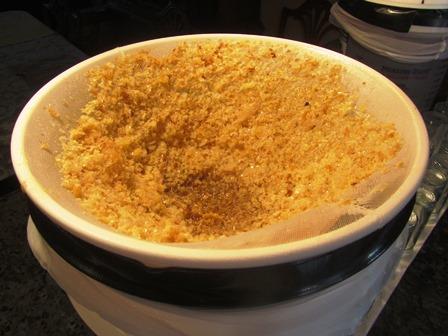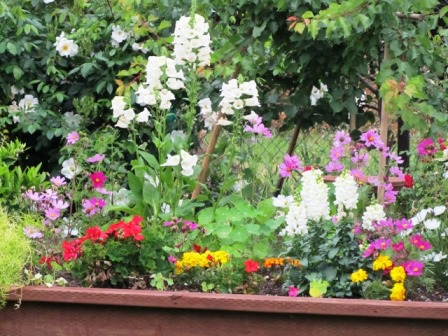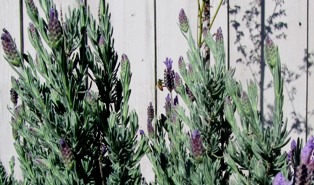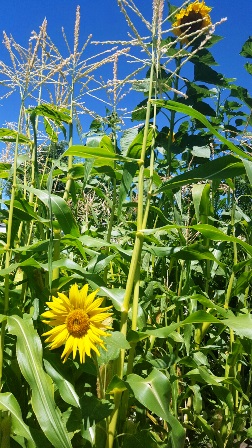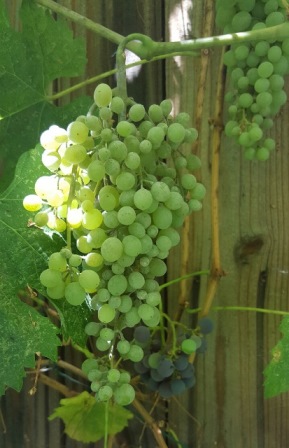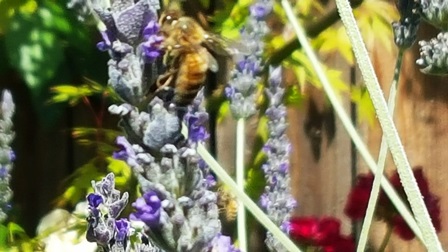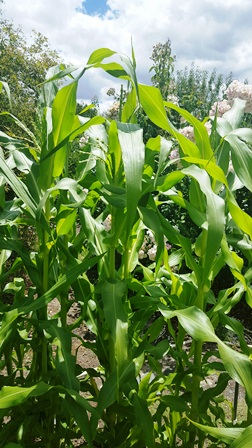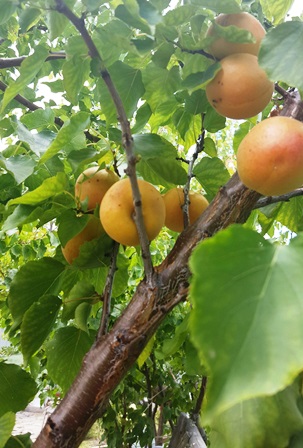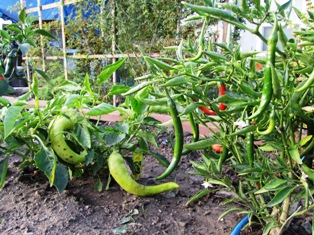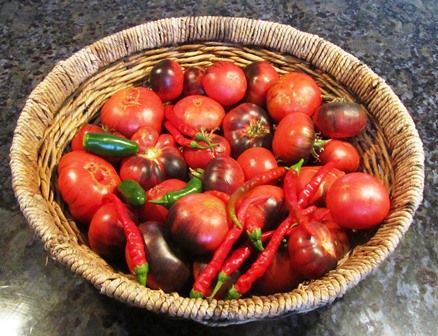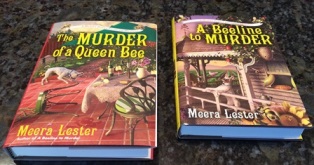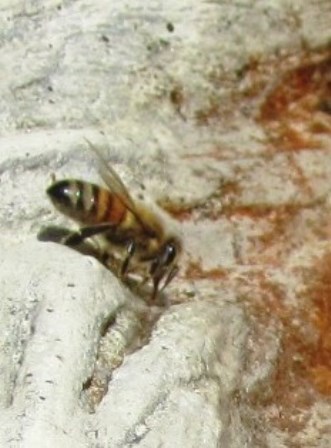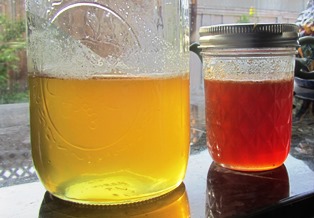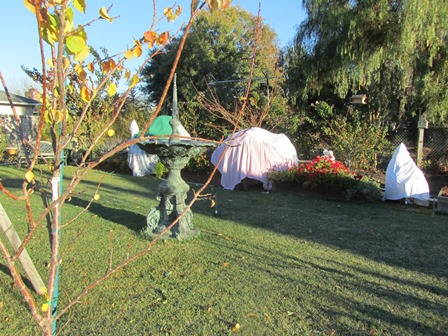Blog Archives
First the Harvest, then the Floor
My kitchen floor was littered with bits of wax and bee glue yesterday. It took me over an hour on my knees to scrub and clean it after I had uncapped thirty frames of honey I’d taken from my hives.
In the process of scraping each frame and then unsealing all the capped cells on the front and back of each frame, drops of wax and propolis, or bee glue (created by the bees from bee saliva, wax, and exudate from botanical sources) fell to the floor. I tracked it from the counter, sink, and extractor on the soles of my shoes.
Even before I put my honey buckets under the extractor spigot, I tape fine mesh strainers over the buckets to catch wax and other debris.
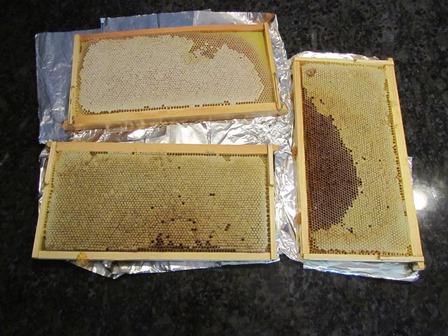
Three frames containing honey, but the sweet stuff is locked inside a honeycomb of cells sealed with wax by the bees
Once all the frames are processed and the buckets are sealed, I put the wax I’ve removed from the frames into a mesh bag to drain the honey (usually a much smaller quantity of honey is recovered from this process).
When the honey has been removed from the mesh bag, I place that wax on a cookie sheet and set it in the garden for the bees to clean. After the bees have cleaned all the wax (by eating any drops of honey left), I save the wax to melt into bars for candles or soap-making.
Back in in the kitchen, the extractor, it must be washed inside and out. Once cleaned and moved to the patio, I must start removing the wax and propolis from the floor. For that, I use an old thin, metal spatula to scrape the tile free of wax.
A soap and water scrub follows. Then I rinse and dry the floor with rags before moving the honey extractor back into the kitchen.
I won’t take honey again until next year. But now the honey must be bottled–that means I must sterilize bottles and prepare labels. Keeping honeybees is really only this labor intensive during and after the honey harvest. But the harvest is well worth all the work.
If you enjoy reading about farmette topics (including gardening, beekeeping, and delicious recipes), check out my cozy mysteries A BEELINE TO MURDER and also THE MURDER OF A QUEEN BEE in the Henny Penny Farmette series (from Kensington Publishing).
* * *
Enjoy reading about farming topics? Check out my cozy mysteries–A BEELINE TO MURDER and also THE MURDER OF A QUEEN BEE (both in the Henny Penny Farmette series from Kensington Publishing).
These novels are chocked full of recipes, farming tips, chicken and beekeeping tips, sayings and, of course, a charming cozy mystery. For more info, click on the links under the pictures.
The books are available through online retailers such as Amazon, Barnes & Noble, Kobo Books, and Walmart as well as from traditional bookstores everywhere.
See, http://tinyurl.com/hxy3s8q
This debut novel launched the Henny Penny Farmette series of mysteries and sold out its first press run. It’s now available in mass market paperback and other formats.
See, http://tinyurl.com/h4kou4g
NEWLY RELEASED! This, the second cozy mystery in the Henny Penny Farmette series, is garnering great reviews from readers and industry publications.
How to Attract Local Pollinators
Today, I spotted a gorgeous bee, big and black with reddish-brown wings, dipping its proboscis into the lavender wisteria and other blooms in my garden. I was stung by a bee yesterday, but that doesn’t stop me from smiling with delight observing this little pollinator at work in my garden.
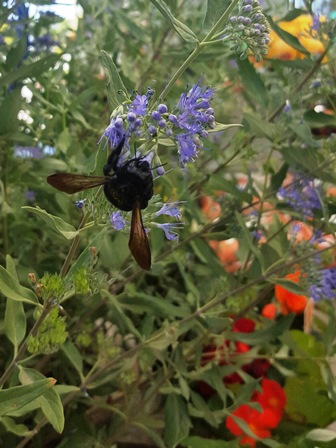
This longhorn bee, twice the size of a honeybee, dips its proboscis (meaning, tongue, nozzle, or snoot) into a bloom.
I admit I’m a fan of pollinators and enjoy watching them work amid the sunflowers, zinnias, cosmos, wisteria, and other blooms in the bee and butterfly garden I planted earlier this year.
The flowers attract hummingbirds, butterflies, bumblebees, and other types of bees, including my own Italian honeybees, the stock of bees most favored in this country (Apis mellifera ligustica). See, http://beesource.com/resources/usda/the-different-types-of-honey-bees/
Honeybees pollinate 90 percent of North America’s commercially produced crops, including almonds. That’s why many Northern California almond growers rent honeybees for use in their orchards during springtime bloom.
The National Academy of Sciences has noted that pollinators are needed to reproduce 75 percent of the Earth’s flowering plants. But there’s been a drop in natural pollinators, in part due to habitat loss and pesticide use.
Populations of the yellow, black, and brown Western bumblebee, once common from southern British Columbia to central California, have now all but disappeared. To attract bumblebees, plant giant hyssop, milk weed, and nettle-leaf horse mint. See, http://www.wildflower.org/collections/collection.php?collection=xerces_bumble
Here’s what else we gardeners and farmers can do to attract local pollinators.
1. Avoid using pesticides.
2. Plant bee, bird, and butterfly friendly native plants.
3. Choose plants that flower in varying diverse colors and shapes to attract a wide variety of pollinators.
* * *
If you enjoy reading about farmette topics (including gardening, beekeeping, and delicious recipes), check out my cozy mysteries A BEELINE TO MURDER and also THE MURDER OF A QUEEN BEE in the Henny Penny Farmette series (from Kensington Publishing).
These novels are available through online retailers such as Amazon, Barnes & Noble, Kobo Books, and Walmart as well as from traditional bookstores everywhere.
See, http://tinyurl.com/hxy3s8q
Now available in mass market paperback, this debut novel launched the Henny Penny Farmette series of mysteries and sold out its first press run.
See, http://tinyurl.com/h4kou4g
The second cozy mystery in the Henny Penny Farmette series, available Sept. 27, 2016
What’s Growing in the July Garden?
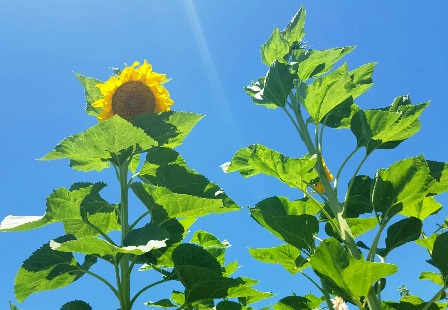
Sunflowers are native to North America and were taken to Europe in the 16th century; however, they date back to roughly 3,000 B.C. Honeybees love sunflowers.
Towering above the squash and lavender in my garden are rows of green corn stalks bearing ears of sweet, plump kernels. Snaking along the rows at the base of the cornstalks are vines laden with butternut squash and Armenian cucumber.
There are ripe tomatoes, too, especially the prolific heirloom–Red Beefsteak. I love cutting up some of these fresh, thin-skin tomatoes and combining them with basil, olive oil, grated cheese, and pine nuts as a topping for pasta. Add some grilled, seasoned chicken and you’ve got a quick and delicious summer lunch.
Zucchini and yellow squash sport large, showy blooms and are producing like crazy this month. While you can harvest and eat the blooms, we prefer the squash. Zucchini is delicious grilled or tossed with rosemary potatoes and onions or made into a French lentil and tomato salad (see recipe from last week’s posting).
Growing on vines trained over a wall and on supports, the green table grapes are beginning to swell. The taste is still a little tart, but will sweeten with the passage of another couple of weeks.
* * *
If you enjoy reading about farmette topics (including gardening, beekeeping, and delicious recipes), check out my cozy mysteries A BEELINE TO MURDER and also THE MURDER OF A QUEEN BEE in the Henny Penny Farmette series (from Kensington Publishing).
These novels are available through online retailers such as Amazon, Barnes & Noble, Kobo Books, and Walmart as well as from traditional bookstores everywhere.
Now available in mass market paperback, this debut novel launched the Henny Penny Farmette series of mysteries and sold out its first press run.
COMING SOON: The second cozy mystery in the Henny Penny Farmette series, available Sept. 29, 2016
Time Spent in a Potager Garden Renews the Spirit
With the official start of summer a few days away, I find myself leaving my computer and the scene I’m writing on my third novel to take a break in the garden. Alive with honeybees, bumblebees, butterflies, and hummingbirds, the garden is perfect place for a respite and a cup of tea.
Quite like a potager garden that includes flowers, herbs, trees, vegetables, berries, and grapes, mine also includes a patch of corn.
Embroidered around the edges of the garden, there are climbing roses, fruit trees, and lots of lavender. Along the rows of lavender, there are peach trees with fruit the size of softballs and five pomegranate trees, laden with blooms and new fruit.
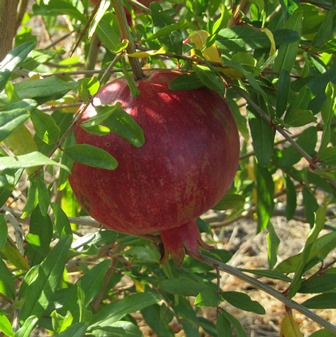
The pomegranates aren’t quite this large yet, but the trees have so much fruit, they’ll have to be thinned.
As I meander, I discover the trees of red and yellow plums have begun to drop their ripe fruit. I’ve got to make those plums into jelly or jam and ditto on the apricots.
But that work will have to wait until my late afternoon tea break. My novel won’t write itself. Still, the time I spend in the garden revitalizes my spirit and refreshes my brain cells, enabling me to return to the computer and the scene I’m writing with renewed vision and vigor.
* * *
If you enjoy reading about gardening, keeping bees, raising chickens, and creating delicious recipes, check out my novels from Kensington Publishing.
The Henny Penny Farmette series of cozy mysteries are available at Amazon, Barnes and Noble, Kobo Books, Walmart, and other online and traditional bookstores everywhere. Available in hardcover, Kindle, and mass market paperback formats.
Lemon Oil for Luring Honeybee Swarms
Call it my sixth sense at work, but after my bees acted aggressive (which they usually are not) as I cleaned the water fountain, I prepared the swarm catcher and put it in the apricot tree nearest my office window. Mid-morning on Wednesday, I got my first swarm of 2016.
Lemon oil is often the ingredient that lures the honeybees to a swarm catcher. I mix the lemon oil mixed with water and spray the swarm catcher with a pump sprayer. It usually works better to capture the bees in the swarm catcher than having them coalesce en masse on an inconvenient limb in a tree, say, fourteen feet up.
You can use lemon oil as a salve or in the oil form–apply the salve onto the swarm catcher around the opening for the bees or use the oil in a small plastic vial that gets inserted into a swarm catcher orifice.
Bear in mind that not all lemon oils are equal. Some are more “lemony scented” than others. Lemon oil is cold pressed from the peel and contains 3 to 10 percent citral (considered the most powerful of components that contribute to the lemon scent). Lemon myrtle contains 95 percent citral and, if it’s the scent you want, lemon myrtle is superior to all others.
So, when I realized my bees were swarming, I suited up and prepared a hive box with ten frames, eight with wax from previous honey harvests (where I left the wax intact) and two that I had in the kitchen where I was draining honey from them. It would provide an immediate source of food for the bees in their new home.
Today, I visited my favorite shop for all things honeybees and stocked up on a couple more hive boxes, just in case of another swarm, although the bees are quiet and non-aggressive again.
Planting the Spring Garden
Winter brought us lots of rain and now the ground has warmed up and is ready to receive the heirloom seedlings of our favorite vegetables and herbs.
Tomatoes won’t set fruit until the nighttime temps hover around 55 degrees Fahrenheit, but I tucked in several seedlings of heirloom varieties (Bradley, Cherokee Purple, and Red Beefsteak). Victory Seeds offers a nice selection of open-pollinated, non GMO, rare heirloom seeds for a variety of tomatoes. See, http://www.victoryseeds.com/tomato.html
While I was digging, my neighbor’s bees decided to swarm. So I stopped gardening to check on my own bees. They’ve been humming like a truck engine, and there has been a lot of bee traffic. Concerned that they might swarm, I set aside my shovel and got out the swarm catcher, the lemon oil, and the hand pump sprayer. I positioned the swarm catcher in a tree across the yard, sprayed the tree with lemon oil, and went back to gardening.
I’ve readied a patch of ground for the sweet corn, squash, peppers, and beans. Also, in a large-size planter pot, I’ve tucked in flat Italian parsley, Italian oregano, dill, chives, and sweet basil. The patio pot will remain near the kitchen slider in full sun so I have culinary herbs at the ready when I need them.
The early sweet peas are taking off now and the garlic and onions I put in the garden last fall are about a foot high. The vegetables and herbs I plant now will provide me with plenty of nutritious offerings right up until late fall–one of the many reasons to plant a garden in spring.
Enjoy this blog? Check out my Henny Penny Farmette novels, available online and in traditional bookstores everywhere.
Swarming Season 2016 Has Started
My beekeeper neighbor was working in his backyard this morning as I typed away on my novel. My office overlooks the garden and the fence between our properties.
Then . . . I heard the familiar clanging of a spoon against a pan. I leaped from my desk chair and ran to the kitchen. There, I grabbed a pot lid and wooden spoon and joined the banging at the fence between our properties.
I could see the brown cloud of honeybees in the air swarming near his apricot tree. We banged away for a while. It’s a bee-disorienting action that compels them to alight in a nearby tree or bush. “Have they landed yet,” I yelled. He replied that they had.
Thus begins the 2016 swarming season for the environs of the Henny Penny Farmette.
Preparing Honeybee Hives for Spring
Recently, I conducted a mid-winter check of my honeybee hives. With my beekeeper neighbor’s help, we opened my Henny Penny Farmette Hives A and B to search for signs of an increase in the mite population, the presence of other pests, and evidence of mold. Inspecting and treating bees with medicines when necessary are important bee management practices.
We found one bug that I couldn’t identify but my neighbor explained it lays a narrow worm and must be removed before its numbers increase. This we did. We also found three frames in Hive B that had a few spots of mold. We threw away the frames and replaced them with wax-covered frames in the lower hive box where the queen had already produced lots of bee babies.
There appeared to be adequate stores of honey, baby bee food, and lots of baby bees. In fact, we removed a few frames of honey from both hives. In their place, we inserted frames that previously had the honey drained off but wax left intact (these I always freeze before putting back into hives since freezing kills mites, larvae, and wax moth), making it easier for the bees to start building comb.
The honey I harvested is dark-colored and earthy tasting, typical of autumn honey when the bees collect pollen from eucalyptus, star thistle, and other sources available in autumn. In contrast, spring honey is light-colored and slightly citrus tasting from pollen gathered from blooming citrus trees and wildflowers.
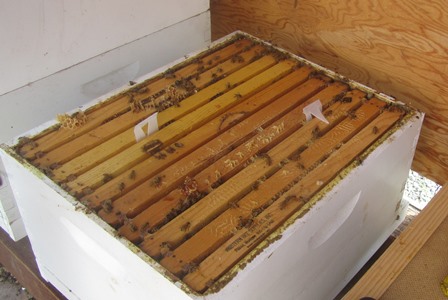
Hang medicated miticide strips between frames inward from the edge of the hive box for mite control.
Since we found evidence of mites, we hung miticide strips between frames to combat tracheal and Varroa mites. Also, we sprinkled powdered sugar medicine (Tetra-Bee Mix 2X Medicated) over the frames to control risk of American foulbrood. Treating the hives thus will enable the bees to remain robust. I expect their numbers to swell with warmer weather which, in turn, translates to new swarms in the spring.
*Apivar is an effective treatment of Varroa mites. One strip per four to five frames works through contact and should be placed in high bee activity areas. Not to be used when honey supers (top hive boxes with frames of honey) are on.
*Tetra-Bee Mix 2 X Medicated is recommended for control of American foulbrood caused by paenibacillus larvae and European foulbrood caused by streptococcus pluton susceptible to oxytetracycline in bees when used as directed.
For more beekeeping tips, delicious recipes, and a wholesome whodunnit, check out my Henny Penny Farmette cozy mysteries: A BEELINE TO MURDER (paperback release in October 2016), MURDER OF A QUEEN BEE (hardcover October 2016), and HIVE OF HOMICIDES (October 2017). Find them on Amazon.com, Barnesandnoble.com and other online and conventional bookstores everywhere.
Tis the Season to Plant Bulbs for Spring/Summer Bloom
- These fragrant lilies return every year and bloom mid-summer
After the recent rainstorm, I walked around my farmette and noticed small slivers of green sprouting up. They seemed to be everywhere.
I could understand the grass coming back, but the sight of summer-blooming lilies shooting through the soil was quite surprising. The sight of them got me to thinking about planting some bulbs for a springtime bloom.
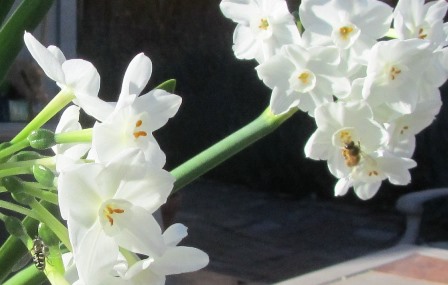
The bees are drawn to the sweet scent of narcissus that have naturalized in the yard and bloom in the spring
Over the weekend, I dug a bed for some tulips and planted nearly 100 bulbs–some early and others late-blooming.
I also will plant some sweetly fragrant grape hyacinth. The bees are attracted to the pollen because of the scent. Honeybees especially love foraging for pollen on violet-hued tulips.
Honeybees need to find pollen all through the year, so planting bulbs that bloom before the spring wildflowers makes sense for those of us who care about the bees.
For tips on farming, raising chickens, keeping honeybees, and creating farm crafts as well as having a good mystery to solve, check out my novel, A BEELINE TO MURDER. It’s available everywhere and also online at Amazon.com and barnesandnoble.com.

Blankets for Trees & Bees on Frosty Nights
I don’t like to take chances with my citrus trees when overnight temperatures drop to near freezing. I cover them with sheets and blankets.
My hives are in a wooden shelter with a tin roof and the back side open, so I can work without any encumbrance. But I don’t want the bees to have to work harder to keep the hive warm for the queen and babies, so I throw some blankets over my beehives, too.
Also, on particularly cold nights, I hang a warming lamp in my chicken house. My rule of thumb for my hens is when overnight temperatures are expected to drop below 45 degrees, I turn on the lamp so the hens aren’t stressed.
An advantage of hanging a heat lamp in the chicken house is to foster egg laying at time when shorter days of light slows egg production. The heat lamp makes light available to the chickens for a much longer period.
 Facebook
Facebook Goodreads
Goodreads LinkedIn
LinkedIn Meera Lester
Meera Lester Twitter
Twitter




